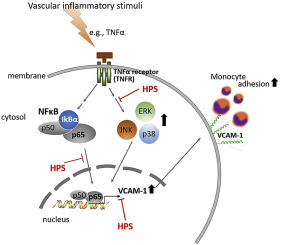Chemico-Biological Interactions ( IF 5.1 ) Pub Date : 2018-08-18 , DOI: 10.1016/j.cbi.2018.08.013 Seon-A Jang , Dae Won Park , Eun Hwa Sohn , Sung Ryul Lee , Se Chan Kang

|
Vascular inflammation has been suggested to play a key role in the initiation and progression of atherosclerosis. Hyperoside (HPS) is a plant-derived quercetin 3-d-galactoside reported to have anti-inflammatory, anti-oxidant, anti-cancer, anti-hyperglycemic, anti-coagulant, and cardioprotective activities. However, the effects of HPS on vascular inflammation have not been studied. Therefore, in this study, we investigated the suppressive effect of HPS on tumor necrosis factor-α (TNFα)-dependent inflammatory responses in MOVAS-1 cells, a murine vascular smooth muscle cell (VSMC) line. HPS did not show any significant cytotoxicity up to 10 μg/mL over 24 h. TNFα challenge of VSMCs significantly increased the mRNA (3-fold) and protein expression (20-fold) of vascular cell adhesion molecule-1 (VCAM-1). However, these increases were abolished in the presence of HPS. Additionally, HPS significantly decreased monocyte adhesion to TNFα–stimulated VSMCs in a dose-dependent manner. Further, TNFα challenge induced activation of mitogen-activated protein kinases (MAPKs), such as p38 MAPK (38.0 ± 3.08 fold), JNK (51.6 ± 2.26 fold), and ERK (14.1 ± 0.77 fold); expression of nuclear factor-κB (NF-κB; ≅ 4-fold) and TNF receptor 1 (TNFR1; 2.7 ± 0.198 fold) were also increased. Notably, the TNFα-induced expression of these molecules was also significantly inhibited by the presence of HPS. Given that p38 MAPK, JNK, ERK, NF-κB, and TNFR1 all play regulatory roles in the expression of VCAM-1, this study provides insight into the mechanism of action of HPS. In summary, HPS can inhibit TNFα-mediated vascular inflammatory responses and has potential as a new anti-atherosclerotic drug.
中文翻译:

Hyperoside通过下调有丝分裂原激活的蛋白激酶和核因子-κB信号传导来抑制肿瘤坏死因子-α介导的血管炎性反应
已经建议血管炎症在动脉粥样硬化的发生和发展中起关键作用。Hyperoside(HPS)是一种植物槲皮素3- d-半乳糖苷据报道具有抗炎,抗氧化,抗癌,抗高血糖,抗凝血和心脏保护作用。但是,尚未研究HPS对血管炎症的作用。因此,在这项研究中,我们研究了HPS对MOVAS-1细胞(一种鼠血管平滑肌细胞(VSMC))中肿瘤坏死因子-α(TNFα)依赖性炎症反应的抑制作用。HPS在24小时内未显示出任何明显的细胞毒性,直至10μg/ mL。VSMC的TNFα攻击显着增加了血管细胞粘附分子1(VCAM-1)的mRNA(3倍)和蛋白质表达(20倍)。但是,在HPS的存在下,这些增加被取消了。此外,HPS以剂量依赖的方式显着降低了单核细胞对TNFα刺激的VSMC的粘附。进一步,TNFα攻击诱导了促分裂原活化蛋白激酶(MAPK)的激活,例如p38 MAPK(38.0±3.08倍),JNK(51.6±2.26倍)和ERK(14.1±0.77倍); 核因子-κB(NF-κB;≅4倍)和TNF受体1(TNFR1; 2.7±0.198倍)的表达也增加。值得注意的是,HPS的存在也显着抑制了TNFα诱导的这些分子的表达。鉴于p38 MAPK,JNK,ERK,NF-κB和TNFR1在VCAM-1的表达中均起调节作用,本研究为HPS的作用机理提供了见识。综上所述,HPS可以抑制TNFα介导的血管炎性反应,并有潜力作为一种新的抗动脉粥样硬化药物。核因子-κB(NF-κB;≅4倍)和TNF受体1(TNFR1; 2.7±0.198倍)的表达也增加。值得注意的是,HPS的存在也显着抑制了TNFα诱导的这些分子的表达。鉴于p38 MAPK,JNK,ERK,NF-κB和TNFR1在VCAM-1的表达中均起调节作用,本研究为HPS的作用机理提供了见识。总而言之,HPS可以抑制TNFα介导的血管炎性反应,并有潜力作为一种新的抗动脉粥样硬化药物。核因子-κB(NF-κB;≅4倍)和TNF受体1(TNFR1; 2.7±0.198倍)的表达也增加。值得注意的是,HPS的存在也显着抑制了TNFα诱导的这些分子的表达。鉴于p38 MAPK,JNK,ERK,NF-κB和TNFR1在VCAM-1的表达中均起调节作用,本研究为HPS的作用机理提供了见识。总而言之,HPS可以抑制TNFα介导的血管炎性反应,并有潜力作为一种新的抗动脉粥样硬化药物。这项研究为HPS的作用机理提供了见解。总而言之,HPS可以抑制TNFα介导的血管炎性反应,并有潜力作为一种新的抗动脉粥样硬化药物。这项研究为HPS的作用机理提供了见解。总而言之,HPS可以抑制TNFα介导的血管炎性反应,并有潜力作为一种新的抗动脉粥样硬化药物。


























 京公网安备 11010802027423号
京公网安备 11010802027423号